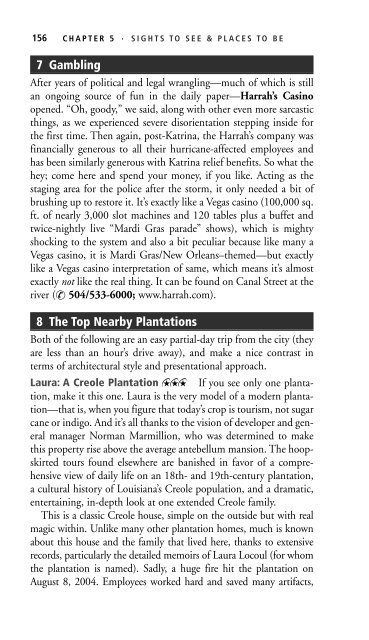Create successful ePaper yourself
Turn your PDF publications into a flip-book with our unique Google optimized e-Paper software.
156<br />
CHAPTER 5 . SIGHTS TO SEE & PLACES TO BE<br />
7 Gambling<br />
After years of political and legal wrangling—much of which is still<br />
an ongoing source of fun in the daily paper—Harrah’s Casino<br />
opened. “Oh, goody,” we said, along with other even more sarcastic<br />
things, as we experienced severe disorientation stepping inside for<br />
the first time. Then again, post-Katrina, the Harrah’s company was<br />
financially generous to all their hurricane-affected employees and<br />
has been similarly generous with Katrina relief benefits. So what the<br />
hey; come here and spend your money, if you like. Acting as the<br />
staging area for the police after the storm, it only needed a bit of<br />
brushing up to restore it. It’s exactly like a Vegas casino (100,000 sq.<br />
ft. of nearly 3,000 slot machines and 120 tables plus a buffet and<br />
twice-nightly live “Mardi Gras parade” shows), which is mighty<br />
shocking to the system and also a bit peculiar because like many a<br />
Vegas casino, it is Mardi Gras/<strong>New</strong> <strong>Orleans</strong>–themed—but exactly<br />
like a Vegas casino interpretation of same, which means it’s almost<br />
exactly not like the real thing. It can be found on Canal Street at the<br />
river (& 504/533-6000; www.harrah.com).<br />
8 The Top Nearby Plantations<br />
Both of the following are an easy partial-day trip from the city (they<br />
are less than an hour’s drive away), and make a nice contrast in<br />
terms of architectural style and presentational approach.<br />
Laura: A Creole Plantation If you see only one plantation,<br />
make it this one. Laura is the very model of a modern plantation—that<br />
is, when you figure that today’s crop is tourism, not sugar<br />
cane or indigo. And it’s all thanks to the vision of developer and general<br />
manager Norman Marmillion, who was determined to make<br />
this property rise above the average antebellum mansion. The hoopskirted<br />
tours found elsewhere are banished in favor of a comprehensive<br />
view of daily life on an 18th- and 19th-century plantation,<br />
a cultural history of Louisiana’s Creole population, and a dramatic,<br />
entertaining, in-depth look at one extended Creole family.<br />
This is a classic Creole house, simple on the outside but with real<br />
magic within. Unlike many other plantation homes, much is known<br />
about this house and the family that lived here, thanks to extensive<br />
records, particularly the detailed memoirs of Laura Locoul (for whom<br />
the plantation is named). Sadly, a huge fire hit the plantation on<br />
August 8, 2004. Employees worked hard and saved many artifacts,


